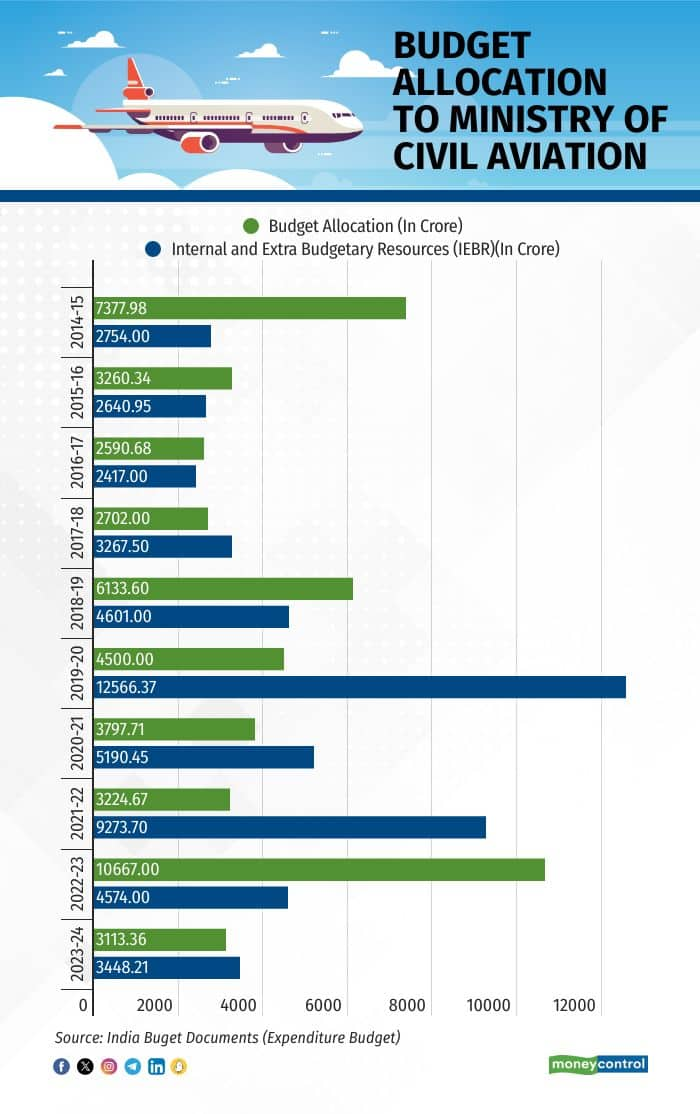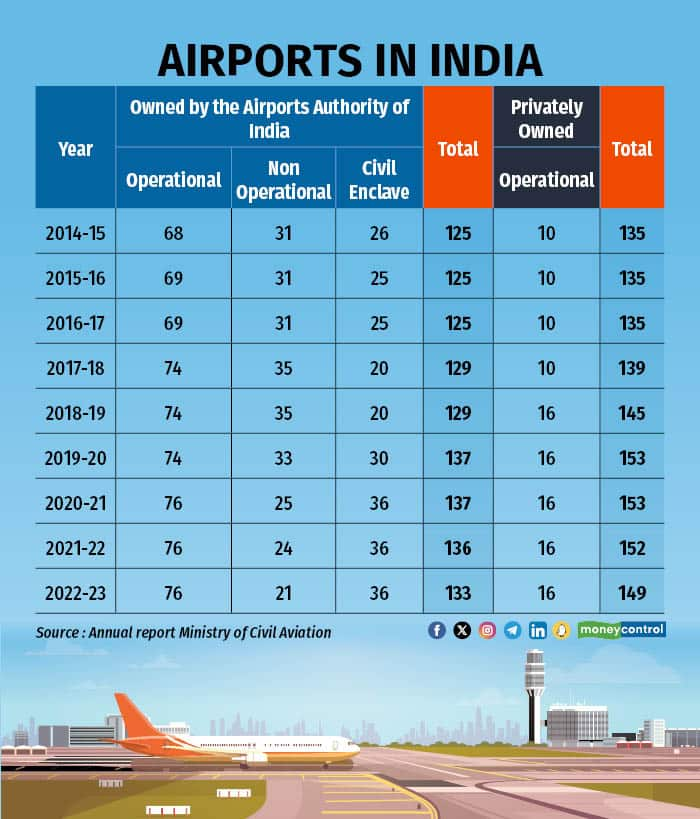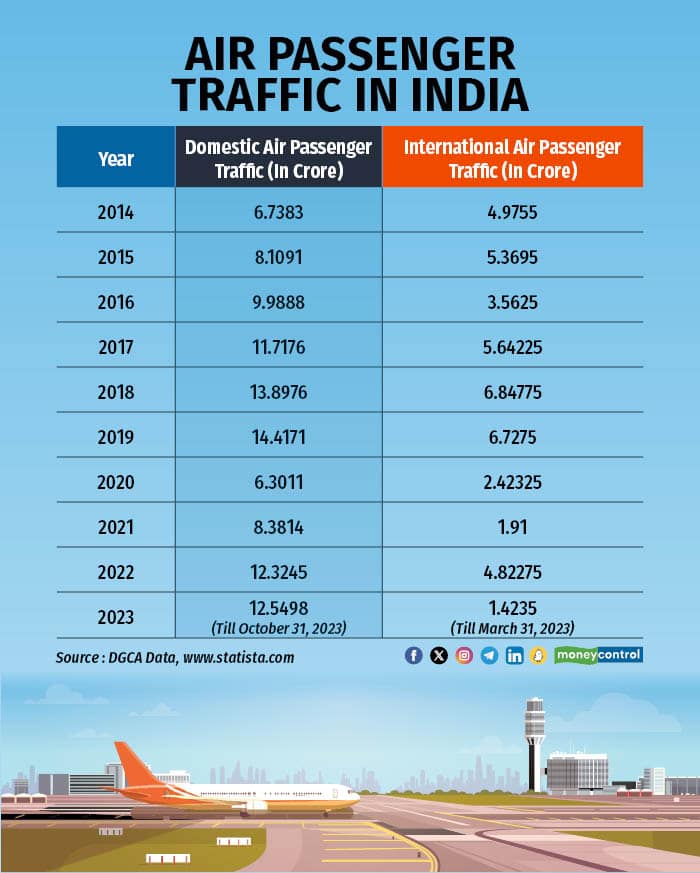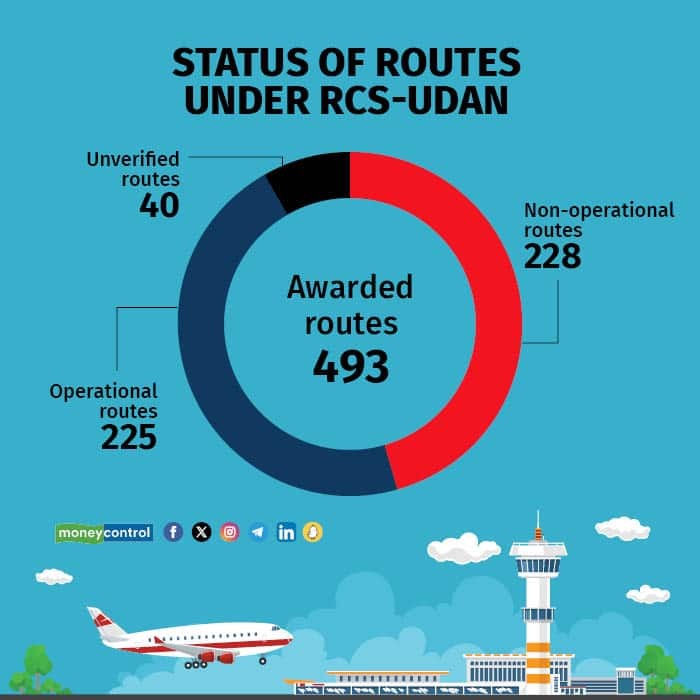



In the last 10 years, India has become the third-largest domestic aviation market in the world, after the US and China, with 4,12,822 Indians flying domestically in 2023 every day, as against 1,84,608 in 2014.
Subsequent budgets over the years have focused on building greater regional connectivity. UDAN (Ude Desh ka Aam Nagrik), or Regional Connectivity Scheme (RCS), was launched in 2016, as part of the civil aviation policy’s objective of improving regional connectivity to Tier II and III cities. It has undergone several iterations since.
In 2023, UDAN 5 was launched, with the aim of starting operations on 50 new routes.
In the last decade, the government managed to privatise Air India. After nearly 20 years of failed attempts, in 2021, the government managed to push through the privatisation of the national carrier and exited the aviation business.
In the last 10 years, budget allocation for the Ministry of Civil Aviation (MoCA) has fallen from Rs 7,377.98 crore in 2014-15 to Rs 3,113.36 crore in 2023-24.
 Budget Allocation To the Ministry of Civil Aviation
Budget Allocation To the Ministry of Civil Aviation
HITS
Aviation Infrastructure
Airports: In the Union Budget 2016-17, Finance Minister Arun Jaitley announced the development of 160 non-functional airports across the country.
According to the annual reports of MoCA, the number of airports in India has increased to 149 in 2023 from 135 in 2014. Similarly, the number of operational airports and civil enclaves has increased to 118 in 2023 from 78 in 2014
 List of Airports in India
List of Airports in India
Passengers: In Budget 2018-19, the government set a target of 855 million air passengers by 2030-31.
Back in 2014, around 67 million domestic passengers had taken to the skies. By 2022, that figure almost doubled to 123.2 million, despite COVID-19 in 2020 and part of 2021.
 Air Passenger Traffic
Air Passenger Traffic
Privatisation
Air India sale: In January 2022, the government completed the divestment of Air India to the Tata Group. The airline, which was nationalised in 1953, returned to the fold of the Tata Group, after burning a hole of roughly Rs 1,57,339 crore in the government’s pocket in 10 years. The Tata Group bid Rs 18,000 crore as the airline’s enterprise value.
Airports: The government completed the privatisation of six non-metro airports — Ahmedabad, Jaipur, Lucknow, Guwahati, Thiruvananthapuram, and Mangaluru — and handed them over, under a public-private partnership, to Adani Enterprises.
Till February 2023, the Airports Authority of India (AAI) has received concession fees of approximately Rs 896 crore from the concessionaires for these six airports.
Further, AAI also received approximately Rs 2,349 crore in the form of an upfront fee for capital expenditure incurred by AAI at these airports.
However, following the first round of airport privatisation, the government has been slow in moving forward. The AAI cleared a list of 13 airports in 2021 for the second round of privatisation under the BJP government but no progress has been made on the privatisation since 2021.
UNFINISHED BUSINESS/MISSES
Airline collapses
Three major airlines have collapsed in India since 2014. SpiceJet went bankrupt and had to find a new owner; Jet Airways collapsed in 2019; and no-frills carrier Go First, earlier GoAir, filed for voluntary insolvency in 2023.
Throughout this period, the government announced two excise duty rate hikes on aviation turbine fuel — in 2015 and in 2016.
The government had hiked the service tax from 12.36 percent to 14 percent for first and business classes in Budget 2015-16, and increased excise duty on jet fuel to 14 percent from 8 percent in the 2016-17 Budget.
In 2014, CAPA India said Indian carriers were expected to suffer losses of $1.3-1.4 billion in 2014-15. Fast-forward to 2023-24. CAPA India expects Indian airlines to record a consolidated loss of $1.6-1.8 billion in the next financial year.
Make-in-India initiatives
To promote domestic manufacturing, the government, in the budgets of 2015-16, 2016-17, and 2017-18, had announced steps such as letting companies borrow money through external commercial borrowings (ECB) for working capital requirements and exempting aircraft spare parts, new and retreaded tires from basic Customs duty, to attract aircraft makers to set up shops in the country and encourage the growth of the local aircraft maintenance, repair, and operations (MRO) industry.
The government has also said that it would bring in policy interventions to ensure self-reliance in the sector.
“The government will adopt suitable policy interventions to create a congenial atmosphere for the development of MRO in the country,” Finance Minister Nirmala Sitharaman said as part of her Budget speech for 2017-18.
While these measures promoted Safran and Airbus to open test centres in India and sign a deal in 2022 to procure 56 C-295MW tactical transport aircraft, the government has failed to attract manufacturers of commercial aircraft to the country.
The lack of manufacturing facilities in India poses a problem for airlines in the country, which suffer from the unavailability of spare parts and engine manufacturing in the country.
The lack of MRO facilities and higher costs also mean that Indian airlines have been dependent on several countries, including Singapore and Sri Lanka, for undertaking MRO options.
Leasing
The Modi government, in Budget 2015-16, had also proposed to make India a hub of aircraft leasing and financing by creating a world-class business district at the Gujarat International Finance Tec-City (GIFT City), the upcoming smart city and financial centre intended to supplant cities like Singapore and London.
With the announcement of tax benefits, such as tax holidays for capital gains, income of aircraft leasing companies, tax exemptions for aircraft lease rental paid to foreign lessors, tax incentives for re-location of foreign funds in IFSC, and tax exemptions to investment division of financial services companies at GIFT City, the expectations were that aircraft leasing companies would look at India as an alternative market.
In 2023, IndiGo and Air India set up their leasing arms in GIFT City, but eight years down the line, not a single commercial airline has transacted through GIFT City.
UDAN
The Regional Connectivity Scheme or UDAN was announced in Budget 2016 to get more ordinary Indians to fly to un-served airports and make air travel affordable.
Since its launch, more than 114 million passengers have travelled on more than 2,16,000 UDAN flights, with the government providing Rs 2,300 crore as a part subsidy, according to data from the Ministry of Civil Aviation.
As of October 3, 2023, after five rounds of bidding under UDAN, 493 routes had, on paper, commenced operations connecting 70 destinations, according to the latest Airports Authority of India (AAI) report.
However, an analysis of operationalised routes awarded by the government under UDAN, based on the flight schedules of airlines and data from travel agents, shows that 225 routes remained operational till October 2023.
Airlines stopped flying on 228 routes for reasons including the lack of infrastructure, low passenger demand, and poor awareness about the scheme.
 Status of UDAN routes
Status of UDAN routes
EXPERT-SPEAK
CAPA India has asked the government to come up with a new long-term aviation policy in the backdrop of the aviation landscape witnessing rapid changes in the post-COVID period.
"The new policy should plan for airport capacity that will last for a generation and beyond, must define an international air services strategy in line with India's national interests as well as restructuring airspace design to provide capacity for up to 8-10x of the current traffic," the aviation consultancy said.
The government should also dismantle the negative fiscal regime and provide adequate infrastructure.
Discover the latest Business News, Sensex, and Nifty updates. Obtain Personal Finance insights, tax queries, and expert opinions on Moneycontrol or download the Moneycontrol App to stay updated!
Find the best of Al News in one place, specially curated for you every weekend.
Stay on top of the latest tech trends and biggest startup news.